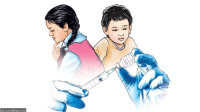Health
Regular vaccination programme takes hit amid Covid-19 pandemic
Doctors warn disruption in the regular immunisation programme could pose a serious risk to children’s health.
Arjun Poudel
Last year in May, when the number of Covid-19 cases spiked in Narainapur Rural Municipality of Banke district, the local administration enforced a strict lockdown. The restrictions not only prevented people from coming out from their homes but also deprived them from getting basic health care, including immunisation services.
The coronavirus infection had emerged as a major public health threat. It was wreaking havoc in almost all the sectors. The country's health care system was buckling under the pressure of Covid-19 pandemic. Regular immunisation services were disrupted in many places including in Narainapur.
With the public transport halted and the fear of the virus infection among the population, hundreds of children missed their regular vaccine schedule throughout the country.
“We found that 135 children missed their regular vaccine after the infection outbreak in our rural municipality,” Nagendra Kumar Shah, health coordinator of Narainapur Rural Municipality, told the Post over the phone. “After the number of new cases started to decline, we mobilised health workers to trace their whereabouts.”
According to the World Health Organisation and UNICEF, 23 million children missed out on basic childhood vaccines through routine health services in 2020 worldwide. It is the highest number since 2009 and 3.7 million more than in 2019.
Narainapur Rural Municipality was one of the most active Covid-19 hotspots. Hundreds of infected people who had returned from India had tested positive for the disease. Local health facilities were overwhelmed and panic had spread among the local residents.
The Ministry of Health and Population said the routine immunisation programme was affected by the pandemic despite the government’s efforts to continue the services.
“Regular immunisation services were not halted for a long time but many people did not seek the services due to various reasons,” Dr Jhalak Gautam, chief of immunisation section at Family Welfare Division, told the Post. “I cannot give you the exact figure of the children who missed their routine vaccines, but the vaccine coverage has declined in our country.”
Regular immunisation of childhood diseases is one of the most successful programmes in Nepal, with a high coverage rate. The country has demonstrated remarkable progress in reducing the under-five mortality rate and the regular immunisation programme is credited for the success.
In 2019, it was estimated that the country reduced its child mortality rate to 31 per 1,000 live births or by 78 percent from the level of 1990.
Doctors warn disruption of the regular immunisation programme could pose a serious risk to child health and increase child mortality rate.
“Several vaccines which have to be administered to children below one year of age cannot be administered later on,” Dr Rita Hamal, a consultant paediatrician at Om Hospital, told the Post. “The risk of infection and mortality rate could increase if the vaccines are not administered in time.”
According to the WHO, the majority of the countries last year experienced drops in childhood vaccine rate and what is concerning is that up to 17 million children likely did not receive a single vaccine during the year, widening already immense inequalities in access to vaccines.
Nepal still has a high child mortality rate and the country has to do a lot to achieve sustainable development goal targets
“A lot of children used to die from measles infection earlier. But with the authorities administering vaccines against the virus, the death rate has declined,’ said Hamal.
Childhood immunisation is the number one priority of the government, under which it provides 12 types of vaccine free of cost.
“Despite the fact that we are struggling to control the ongoing coronavirus pandemic and all energy is spent on it, we should not forget that we have several other responsibilities. The problems we had earlier have not gone anywhere,” Dr Senendra Upreti, a former health secretary, told the Post. “Achievements we made in the child health sector could backslide if we do not pay attention to fulfil the gap.”
Nepal's current neonatal mortality rate is 21 per 1,000 live births, and infant mortality rate is 32 per 1,000 live births. The numbers have remained stagnant for the last several years.
“Even as countries clamour to get their hands on Covid-19 vaccines, we have gone backwards on other vaccinations, leaving children at risk from devastating but preventable diseases like measles, polio or meningitis,” WHO Director-General Dr Tedros Adhanom Ghebreyesus said recently. “Multiple disease outbreaks would be catastrophic for communities and health systems already battling Covid-19, making it more urgent than ever to invest in childhood vaccination and ensure every child is reached.”




 9.12°C Kathmandu
9.12°C Kathmandu














